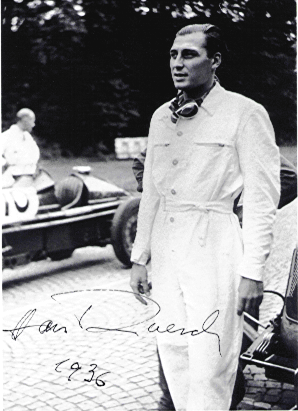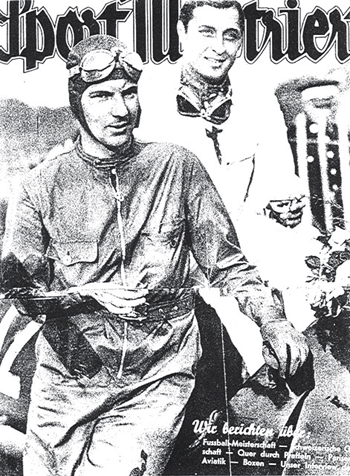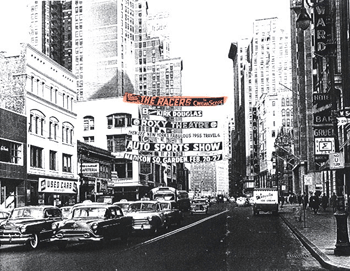17/5/1913 - 27/8/2007
Record updated 20-Jan-23
Hans Ruesch won 27 Grand Prix before the war and is probably the last remaining pre-war Grand Prix winner. After racing he became a best selling novelist before turning his attention to the animal rights movment, establishing a foundation in Switzerland to campaign against vivisection.

Hans Ruesch was born in Naples of an Neapolitan speaking Swiss mother and a German born father. He spent the first 13 years of his life in Naples where his father was an industrialist/archaeologist specialising in Pompeian Art.
Hans spoke German with his father's side of the family and Italian with his mother's. He spent five years at boarding school where he added French to his list of languages. After a brief spell studying law at University in Zürich, he quit in 1932 to go racing, his first competition being in an MG at the Klausenrennen however he got serious later in the year when he drove an Alfa Romeo to third in the 1.5 litre class in the Brno Grand Prix (Masaryk-Ring) and took wins in Switzerland in the hill-climbs at Jaunpass, Klausen and Rheineck-Walzenhausen.
In 1933 he set a new standing start kilometer record at Montlhery in a 3 litre monoposto Maserati at 88.33 mph. In hill-climbs he won at Gometz-Le-Châtel, Rheineck-Walzenhausen, Gaisberg and Semmering, the last two in Austria. He raced a Bugatti 51A in the Grand Prix at Lwow in Poland in June but retired
He acquired the ex-Guy Moll Maserati 8CM (3022) in 1934 winning the Eisrennen or ice races at Titisee on February 4th and Eibsee later in the month on the 18th. Both races were held in Germany. The Titisee event was held on a short 1.5 km oval marked out on the frozen lake. Ruesch covered the 10 laps at the average speed of 85 kph. Two weeks later he won the at Eibsee, near Garmish-Partenkirshen. He also won the 500 Metres Lances Nice and the hill-climb at Rheineck Walzenhausen.
The rest of his season was beset with problems. He entered the Mille Miglia with Ulrich Mang on April 7th but failed to finish. At the Eifelrennen at the Nürburgring in June he was not classified and at the German Grand Prix his fuel pump failed six laps from the finish. He failed to take the start of the Swiss Grand Prix having been drawn in fifth place on the grid and in the Italian Grand Prix he was disqualified for receiving outside assistance after running out of fuel out on the circuit and being met outside the pits by a mechanic.
In 1935 still racing the 8CM, now modified with a 6C/34 engine (3024), he started his season on February 10th with a third place finish at the Norwegian Grand Prix at Bogstad. The Grand Prix was an ice-race held on Lake Bogstadvannet near Oslo. He also raced at Lake Vallentuna outside of Stockholm a week later but a puncture put him out while lying third. He then traveled to Pau for the Grand Prix on the 24th but his car was delayed in customs and was not released in time to compete.
In April he was in Italy for the Mille Miglia with his 2.3 litre Alfa Romeo Monza driving with Guatta, following the tragic death of Mang, and finishing fourth. Later in the month he drove in the Targa Florio finishing eighth.
His next stop was Tripoli on May 12th with the 8CM for the Grand Prix at Mellaha Lake, an 8.165 mile track situated in a salt basin between Tripoli and Tagiura. Qualifying was by a draw and in the race the oil pump on the Maserati failed after six laps. Two weeks later he failed to make the start at Avus.
On June 16th the ADAC Eifelrennen was run to 1500cc Voiturette regulations with Ruesch driving a Maserati 4CS. The works ERA's were there with Raymond Mays, Humphrey Cook and Tim Rose-Richards and a private ERA with Dick Seaman at the wheel. The works ERAs led away but Seaman stormed through from seventh to third on the first lap. Late in the race Ruesch had moved up to third when Seaman, then leading, had to pit for oil. Mays took the lead and managed to hold off Ruesch to take the chequered flag and the first international win for ERA.
In July he was back in the 8CM finishing sixth in the Dieppe Grand Prix and the following week entered the German Grand Prix at the Nürburgring. In a memorable race, in front of over over 250,000 spectators, Nuvolari won in an Alfa Romeo, upsetting the might of Mercedes and Auto Union. Ruesch in his Maserati finished 10th, the first privateer home.

In August he entered the 1500cc voiturette Prix de Berne, held the same day as the Swiss Grand Prix. Ruesch finished sixth in the race won by Dick Seaman in the ERA B. He also won the hill-climbs at Grand Saconnex and Kesselberg that year.
He began 1936 in May when he retired his Maserati Tipo 34 after 13 laps of the Grand Prix in Tripoli at Mellaha Lake. In July at the Grand Prix de l'Albigeois at Albi he finished third in his 4CM in both his heat and the final which was won by Bira in his ERA-B. He then acquired the ex-Nuvolari Scuderia Ferrari straight eight Alfa Romeo 8C-35 (50013). At Pescara in August for the Coppa Acerbo he finished fifth, four laps down on the three works Auto Unions and Brivio's Alfa Romeo 12C-36. Rosemeyer took the win seven minutes ahead of his team mate, von Delius, in second. Earlier the same day, in the voiturette support race, he came third in his 4CS in a race dominated by Seaman in a Delage 15S8. Later in the month he drove the 4CS to fifth in the voiturette Prix de Berne.
He brought the Alfa Romeo 8C-35 to England and entered the hill climb at Shelsley Walsh finishing second in the over 3 litre class and then entered it into the British Grand Prix sharing the drive with Dick Seaman. Ruesch took the first stint taking the lead on lap three and holding it with some ease, though he did have a slight brush with Bira's Maserati, until handing over to Seaman on lap 60. Seaman proceeded to cruise to the finish three minutes up on Charlie Martin's 3.2 litre Alfa in second. He entered the Mountain Championship at Brooklands on 17th October, a scratch race over 10 laps. Raymond Mays got away quickest with Ruesch seeming to take a little time to get to know the circuit. As the race progressed he quicker, crossing the line in second. He lodged a protest stating that Mays had jumped the start but this was not upheld. However Charlie Martin and Austin Dobson were found to have got away too soon and were thus penalised one minute.


That year he also won the Grand Prix du Bremgarten, the Course de Gyon as well as the Course du Kilometre de Gyon in Hungary. He took wins in the hill-climbs at Lapize in France, Harmashatarhegy in Hungary and came second at Develier-les-Rangiers.
At the end of the year he traveled to South Africa with the Alfa Romeo 8C-35. Auto Union also decided to make the trip for the 3rd South African GP held on the rough and narrow Prince George Circuit in East London. The race was on January 1st 1937 to a handicap system. The Auto Unions were running on experimental synthetic tyres which proved their downfall as they required frequent stops, Rosemeyer having to pit his Auto Union Type C five times. Rosemeyer set the fastest time at an average speed of 108,16 mph but was classified fifth on handicap. Ruesch was second fastest and 4th on handicap. The race was won by Pat Fairfield, who had a handicap advantage of 28 minutes and 13 seconds, in ERA R4A at an average speed of 89,17 mph. The circus then moved to Grosvenor Park, Pollsmoor, Cape Town for the Grosvenor Grand Prix. The race was organised by A.O. Edwards, the chairman of the Grosvenor House Hotel in London, England. The Auto Unions, though disappointed by the handicap system, were there as was Ruesch, with a 5 minute 47 second advantage over Rosemeyer. This time the Auto Union strategy was better and they finished first and second with Ernst von Delius taking the honors. Ruesch was classified fifth.
Back in Europe for the 1937 Grand Prix season, the fifth AIACR European Championship, Hans competed in three of the five rounds. He finished 8th in Monaco and Germany. In the Swiss Grand Prix he retired with a cracked cylinder after just eight laps. The championship was won by Rudolf Caracciola, driving for Mercedes-Benz. Ruesch finished 12th.

Away from the championship, Ruesch fared much better winning the Finnish Grand Prix at the Circuit d'Elaintarhanajo on May 8th and the Grand Prix des Frontières Chimay on the 16th. He rounded out the month with another win, this time at the Bucharest Grand Prix on the 30th.
He came third in the Circuit de Milan in June behind Nuvolari and Giuseppe Farina but at the Coppa Acerbo at Pescara in August he crashed out. Ruesch returned to Brooklands in October, this time winning the Mountain Championship by over 22 seconds. That year he also won the hill-climb at Rheineck-Walzenhausen in Switzerland for the forth time, the Grand Prix du Bremgarten and the Coupe de Vitesse.
At the beginning of April 1938 Ruesch loaned the Alfa Romeo 8C-35 to Buddy Featherstonehaugh to race at Crystal Place in the Coronation Trophy. After finishing 5th in his heat 5th in heat, he spun and stalled in the final at Fisherman's Bend. Later in the month Ruesch again entered the car for Featherstonehaugh this time in the British Empire Trophy at Donnington. However Buddy somersaulted the Alfa in the practice session. The car was also entered for the Campbell Trophy at Brooklands on Easter Monday, 18th April, but could not be repaired in time.
In 1939 with the political situation in Europe deteriorating, Ruesch sold the 8C-35 Alfa Romeo to Robert Arbuthnot and moved to Paris, where he began writing, something that he had a passion for when he was younger. He had made a scouting trip to America in 1938 and with the Germans one day away from Paris and the borders closed, he headed for Spain armed only with a transit visa. He was arrested in Madrid but, with the help of a female friend, managed to get released and continued on to Lisbon where he stayed for six weeks before traveling on to the America. He settled in New York studying creative writing. He took up writing full time and had short stories published by Redbook Magazine, Colliers, Saturday Evening Post and Esquire.
He returned to Europe in 1946, landing in Naples, a town scarred by the ravages of war and in 1949 married Maria Luisa De La Feld. Often compared to Conrad and Jack London, he wrote a number of books including the best selling 'Top of the World' in 1950 that was made into the 1960 film 'The Savage Innocents' staring Anthony Quinn and Peter O'Toole and 'The Racer' in 1953 that became a film of the same name staring Kirk Douglas.

In 1953 he made a brief return to racing in a Ferrari 4.1-litre 340 MM Spider sports car in the Gran Premio Supercortemaggiore, a sportscar race held on public roads in the area of Bolzano. He qualified in 10th but in the race, which was won by Juan Manuel Fangio, he spun just outside the town of Merano and ran into a small crowd. Two were Carabinieri and one of them, Aldo d'Egilio, was killed instantly, the other policeman, Ezio Saltori and the two spectators Domenico Avi and Enrico Jui were seriously injured but survived. Hans didn't race again.
An animal lover since his childhood, in the 1970s while living in Rome, he became an activist against animal experiments and vivisection after being shown a kitten that been rescued from a vivisection laboratory. He had also been deeply affected by the death of his baby brother, Konrad, some 50 years earlier. Konrad had become ill due to an excessive intake of protein while breast-feeding. He was treated with a drug containing arsenic and mercury that had been tested on animals and approved. The drug, known as 606, had won a Nobel Prize for Paul Ehrlich. Ruesch became convinced that medical research could not properly progress using these methods.
He separated from Maria Luisa about this time, she died in 2006.
In 1974 he stated that he would never again write fiction whilst vivisection continued. He founded CIVIS (Center for Scientific Information on Vivisection) and devoted the rest of his life to the abolition of vivisection. He started writing exposés of the animal experimentation industry, cataloged in his books the Naked Empress, The Great Medical Fraud and the Slaughter of the Innocent and published The International Foundation Report Dedicated to the Abolition of Vivisection.
He had been ill for some time and had suffered for failing eyesight. He died in Massagno, near Lugano, on Monday 27th August 2007 aged 94.
Some of the books he has written are:
Top of the World, 1950
The Racer, Ballantine Books, 1953 Hardback
Rennfahrer, Hamburg, Rowohlt, 1955
The great thirst, Hutchinson, 1957
Der schwarze Durst, Ullstein, Berlin 1959
The Savage Innocents, 1960
The Stealers, London, Hutchinson, 1962
Back to the Top of the World, Charles Scribner's Sons, 1973
Iglus in der Nacht, Fischer, Frankfurt/Main, 1974
Arab, New York, Ballantine, 1974
Emperor Knot, CIVIS, 1976
Slaughter of the Innocent, Animals in Medical Research, New York, Bantam, 1978
Naked Empress or The Great Medical Fraud, CIVIS, 1982.
Die Pharma Story, München, Hirthammer, 1985
1000 Doctors Against Vivisection, Massagno, Switzerland, 1989.
The Unmasked Medicine, Massagno, Switzerland, 2005
The daughter of the Emperor, Massagno, Switzerland, 2006
He leaves a daughter, living in the USA and two sons, both in Switzerland.
historicracing.com
POPULAR DRIVERS FROM CH
Christian Kautz
Xavier Perrot
Florian Vetsch
Jo Siffert
Bruno Saby
Albert de Bomdeli
Philippe Siffert
Peter Hirt
Silvio Moser
Clay Regazzoni